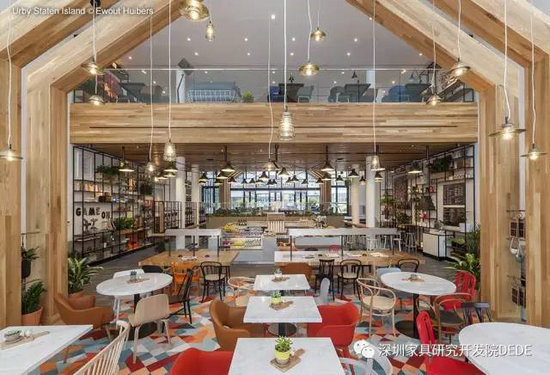當飛機緩緩降落,倫巴第平原的冷空氣想要迅速地包圍你。那一刻,一年一度的米蘭國際家具展正等你到來。深圳家具研究開發院DEDE潮流趨勢專家調研團和你一樣,再一次啟程了。在這里我們將以專業視角,同步為您推送、解析這場盛宴。
今天為您分享的是,2017年米蘭展官方潮流趨勢關鍵詞:co-living(合居合住),為了便于您獲取原汁原味的信息,我們采用了中英文雙語推送。
■ 這些年,我和我們發生了什么

▲用人種志和藍色天空法繪制的生活形態坐標
金融危機過去快十年了,共享型經濟正日益崛起,促使人們的生活方式進化,特別是“Y生代”(年輕一代)。如今,共享型產品和服務正在被人們擁抱。
The financial crisis and the advent of the sharing economy are impacting significantly on the evolution of people’s behaviours and lifestyles, especially those in the younger age brackets. The so-called Millennials, or representatives of what is known as Generation Y, have embraced concepts such as sharing and immediate and unrestricted “access” in relation to goods and services.

■ 生活=所有權=服務
不無例外的是,家庭和生活方式也穩步地“優步化了”(優步:一種在移動端的共享型打車軟件,已退出中國大陸,你可能更熟悉它的“中國版”——滴滴打車)。從那些國際領先型城市中心的生活方式中,接下來的這個公式概念愈發成立:“生活=所有權,生活=服務”。大城市里的人們生活成本飆升,在住房領域,抵押貸款需要越來越多的實體擔保,合同往往不那么靈活,可支配的收入(存款)普遍不高。生活作為一種服務,我們不如縮寫為LAAS,意味著像優步等一樣的服務,會幫助我們在傳統的“買房”或“租房”中尋求新的解決方案,而現在我們多了一個“訂閱”功能。
Homes and lifestyles are no exception to what could be seen as the steady “uberisation” of all aspects of consumption. The leading international urban centres are seeing the inception of new habitative formulae, marking the passage from the concept of “living” implying “ownership” to the concept of “living” implying “service”.The soaring costs of living in the great cities, mortgages requiring increasingly substantial guarantees, contracts that are often inflexible, and a widespread fall in disposable income are also fuelling the spread of on-demand models in the housing field. Living As A Service, or its acronym LAAS, means precisely that – just like services such as Uber, Netflix and Kindle; in addition to traditional house buying or renting solutions, there is now a “subscription” option.

■ 不強調擁有,而是曾經擁有
這個新的、蠢蠢欲動的真實需求會讓越來越多的人嘗試改變自己的生活習慣,我們的住宅會越來越強烈的“社交化”,這意味著共享會是很自然的事情。These new, very real demands from a large slice of the population are generating new genres of residential facilities, strongly “socialising” in nature, and new shared understandings of what habitation means.越來越多的人們要花比以前更長的時間來“暫停成年”(DEDE譯注:從學生時代到進入社會后,繼續群居會讓學生式的時間變長)。換句話說,在建立社會關系、文化身份之前,他們需要花更長的時間來磨礪自己,直到自己的牢固確立了(DEDE譯注:所謂先立業后成家,恐怕老外也是這樣)。其結果是,我們對承諾和穩定性的欲望在減少,在擁有產品所有權面前,更加重視體驗的質量。人們思考的重點變成了:在哪里生活、怎么生活、如何享受相同水平的舒適、靈活性、及時享樂。我們真得感謝這十年發展起來的互聯網新技術,它讓我們不再固化生活的思維。在倫敦老街區和美國紐約布魯克林社區里提供的一些新型住宅,讓我們看到了這種創新在發揮作用,新的社會意識在形成。
More and more people are going through a much longer “suspended adulthood” than in the past, in other words, they are taking longer to hone their own social, cultural and relational identities before they become firmly established. The upshot is a diminished desire for commitment and stability, with greater value placed on the quality of experiences than on the ownership of goods just for the sake of it or seeking out – including where and how to live – the same level of convenience, comfort, flexibility and immediacy to which they have become accustomed thanks to the new technologies.The Collective Old Oak in London and the Common in Brooklyn are state-of-the-art residential complexes that provide an innovative response to these emerging new demands, leveraging a renewed sense of community.

這個概念就是部分的學生宿舍+部分的酒店,會員每月支付租金(老外稱為“訂閱”),以此得到私人公寓和共享的公共空間、休息室和用餐區、甚至是廚房、花園以及工作站、wifi、會客室、清潔服務、安全服務、電影院、水療中心、健身房等設施(真是無奇不有啊)。
Their concept is part student lodging and part hotel. Members pay a monthly subscription, for which they get a private apartment and access to communal spaces – lounge and dining areas, a kitchen, garden – as well as workstations, WiFi, concierge, cleaning, security services and cinema, spa and gym facilities.

■ 不妨把問題交給設計師
因此,公共生活(co-living)的難題就交給建筑師、室內設計師了,挑戰隨之而來,公共生活是個大雜燴,意味著家庭越來越可變,空間容納著不同的人、不同類型的家庭和不同類型的生活方式、價值觀、興趣愛好、生活選擇。甚至還以為著把空間分享給人類的朋友——寵物。因此在此基礎上,顯然這個潮流趨勢繼續演化成兩個議題——“為合居者設計”、“為寵物設計”。(DEDE注:下期讓我們繼續分享)Communal living has thus become one of the major design challenges facing architects and interior designers at various levels. Co-living, therefore, means that homes are increasingly becoming places of variable geometry capable of housing several different generations and different types of families and communities with shared habits, values, interests and life choices.Co-living also means sharing the domestic space not just with other human beings but also with animals - cats and dogs in the main - which bring their own specific demands and requirements. This has triggered two macro-trends: Co-housing and Pet Style.

▲2017歐洲版白皮書=科隆展+米蘭展雙展圖集
■請繼續關注2017米蘭展展潮流趨勢后續報道。
■FT2017家具潮流趨勢發布會將于5月首發。





